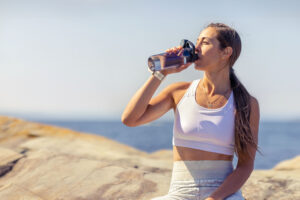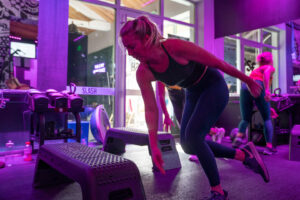-
Cool Down:
After your workout, engage in a 5-10 minute cool-down session that includes light aerobic exercises and static stretches. This helps gradually lower your heart rate and prevent blood from pooling in your muscles. -
Hydrate:
Rehydrate by drinking water to replace the fluids lost during your workout. Proper hydration supports muscle function and helps with overall recovery. -
Nutrition:
Consume a balanced meal or snack that includes a combination of protein and carbohydrates within 1-2 hours after your workout. Protein supports muscle repair, while carbohydrates replenish glycogen stores. -
Stretching:
Incorporate dynamic and static stretching to improve flexibility, reduce muscle tension, and prevent muscle imbalances. -
Foam Rolling:
Use a foam roller or other self-myofascial release tools to massage and release tension in your muscles. This can help alleviate muscle soreness and improve range of motion. -
Active Recovery:
Engage in light, low-impact activities such as walking, swimming, or cycling at an easy pace. This promotes blood flow and helps prevent stiffness. -
Sleep:
Prioritize quality sleep to allow your body to recover and repair. Sleep is essential for muscle growth, hormone regulation, and overall well-being. Rest Days:
Incorporate rest days into your training plan to give your muscles and central nervous system adequate time to recover. These days are just as important as your workout days.
Massage:
Consider getting a professional massage to release muscle tension, improve circulation, and promote relaxation.
Epsom Salt Bath:
Soaking in a warm bath with Epsom salts can help relax muscles and relieve soreness. Epsom salts contain magnesium, which can be absorbed through the skin.
Compression Garments:
Compression clothing can help improve blood circulation and reduce muscle swelling, potentially enhancing recovery.
Cold Therapy:
Applying ice or cold packs to sore areas can help reduce inflammation and alleviate muscle soreness. Consider trying out Slash Fitness’s Fire & Ice class, which combines outdoor functional style training with a therapeutic ice plunge.
Proper Clothing:
Wear comfortable, breathable clothing post-workout to allow your body to cool down and prevent excess sweat buildup.
Mindfulness and Relaxation:
Practice relaxation techniques such as deep breathing, meditation, or yoga to reduce stress and promote mental well-being.
Stay Active:
Incorporate gentle, low-impact activities on rest days to maintain mobility and prevent stiffness without putting additional stress on your body.
Monitor Progress:
Keep track of your workout intensity, duration, and recovery strategies. Adjust your routine as needed based on how your body responds.
Avoid Overtraining:
Be mindful of signs of overtraining, such as constant fatigue, declining performance, and persistent muscle soreness. Adjust your workout routine and recovery strategies accordingly.
Remember that recovery is a personalized process, and what works best for one person may not work as effectively for another. Therefore, it is important to listen to your body and prioritize strategies that make you feel better and support your overall fitness goals. If you’re unsure about the best recovery approach for you, talk to one of Slash Fitness’s trainers and we’ll figure out what kind of post-workout recovery strategies are best for your needs.





